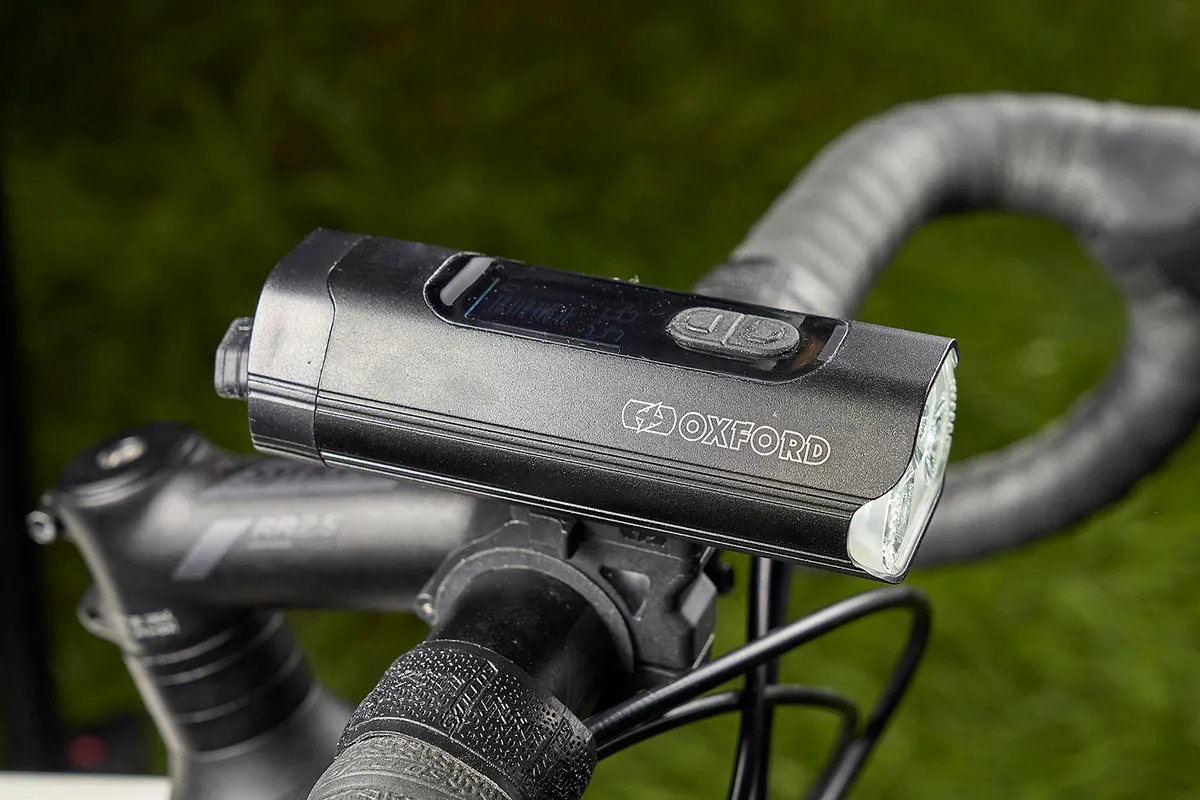The Oxford Ultratorch CL1600 provides a high output at a budget price, making it a good choice for road riding and commuting in the winter months.
It’s a large unit, but mounts securely and easily to the handlebar.
The two mode buttons and large LED display make it easy to use, while a USB-A socket means it can double up as a power bank for other devices.
Although the waterproof rating isn't the best and run time isn't that generous, the balance of price and functionality make it a worthy contender to illuminate your nighttime rides.
Oxford Ultratorch CL1600 specifications and details

The Ultratorch CL1600 offers eight light modes: five constant and three flashing.
Its maximum 1,600-lumen output gives a claimed one-hour run time. The lowest-output 30-lumen constant mode extends this to 40 hours, and the lowest-output flashing mode as far as 80 hours (claimed).
The one-hour run time seems accurate. During testing, I rode for up to an hour at a time, while switching modes, and the light showed only around 50 per cent battery drain.
The Ultratorch is controlled using a pair of buttons on the top of the unit, which enable you to cycle up or down between the eight available modes.
Below this is a large LED screen, which shows the mode in use, battery level via a series of lines and a figure at the top for the remaining run time.
The IPX4 waterproof rating is a little lower than some of the best bike lights, which are often rated IPX6 or IPX7. This means the light is rated as protected from splashing water (for context, IPX6 indicates protection from powerful water jets, and IPX7 from immersion).

Depending on where you ride, this may not be a problem, but if you often ride in the wet, you may want to look for a higher rating.
Having said that, the most typical place for water to find its way into a light is through the charge port, which here is particularly well protected, because it sits beneath a deep bung with two ridged seals.
There’s also a USB-A socket in there, which enables you to use the Ultratorch as a power bank for other devices.
The Oxford Products plastic mount attaches to the bars with an Allen bolt. The light clips vertically into this and there’s a small lever on the mount’s side to release the light again.
You can place the mount on your bars in either direction, meaning you can position the light either further forward or towards the rear on your bike. In testing, the light wobbled from side to side a little, but it didn't appear to affect the beam’s aim.
Oxford quotes a fairly long four to five hours to completely charge the light, possibly because it doesn’t use the latest USB-C standard. There’s a micro-USB cable but not a charger included with the light.
Oxford Ultratorch CL1600 performance

The Ultratorch is a large unit, which takes up quite a bit of bar space. That means there’s space for a large lens in front of the three LED lamps.
There’s also particularly good side illumination, with two large side ports to the lens.
With eight mode options, having two buttons to scroll up or down (rather than having to cycle round) is a bonus, although it’s fairly easy to plunge yourself into darkness or select a flashing mode by accident.
The LCD display screen is particularly large and provides a good deal of relevant information.
It’s useful to be able to see the mode you're in and forecast run time, although I wasn’t sure how accurate this was, because it didn’t always change as I switched between the three highest outputs.

Like most bike lights, the Ultratorch gets quite hot when in use.
On a road bike, the large light format takes up a significant amount of bar space; Oxford’s CLIQR mount makes getting it on and off easy though.
The light output is quite diffuse and even, and there’s no pronounced central spot, making it feel less bright than its output would suggest.
That means that there’s a good spread to the periphery, but it’s not so easy to see obstacles directly ahead on the road.
Oxford Ultratorch CL1600 bottom line

The Oxford Ultratorch provides a lot of illumination for its price.
Although the run time may not be spectacular, it’s reasonable and it’s easy to decrease the light level to conserve battery, although the even light spread means you may want to use the higher-output settings.
The LED battery level and remaining run-time indicator are also useful to manage your usage and illumination.
How we tested | front lights
Front bike lights are essential accessories if you intend to ride at night, in dark and gloomy conditions or simply want to be seen more easily on your regular rides.
For our 2023 testing, we selected the pick of the latest higher-lumen output models, designed for road and gravel riding, to see how they fared.
Big lumens aren’t the be all and end all, though. Our testing included using the lights in varying modes, in diverse weather and light conditions, while assessing the beam shape on the road (and gravel path).
We also checked burn times and highlighted notable plus or minus points when it comes to usability and installation.
Lights on test
Product
| Brand | Oxford |
| Price | £70.00 |
| Weight | 240g |
Features
| Light type | front |
| Integrated battery | yes |
| Features | Run time (full beam): 1 hour IP rating: IPX4 Battery capacity: 2400mAh Modes: 8 |
| Output (lumens) | 1600 |
